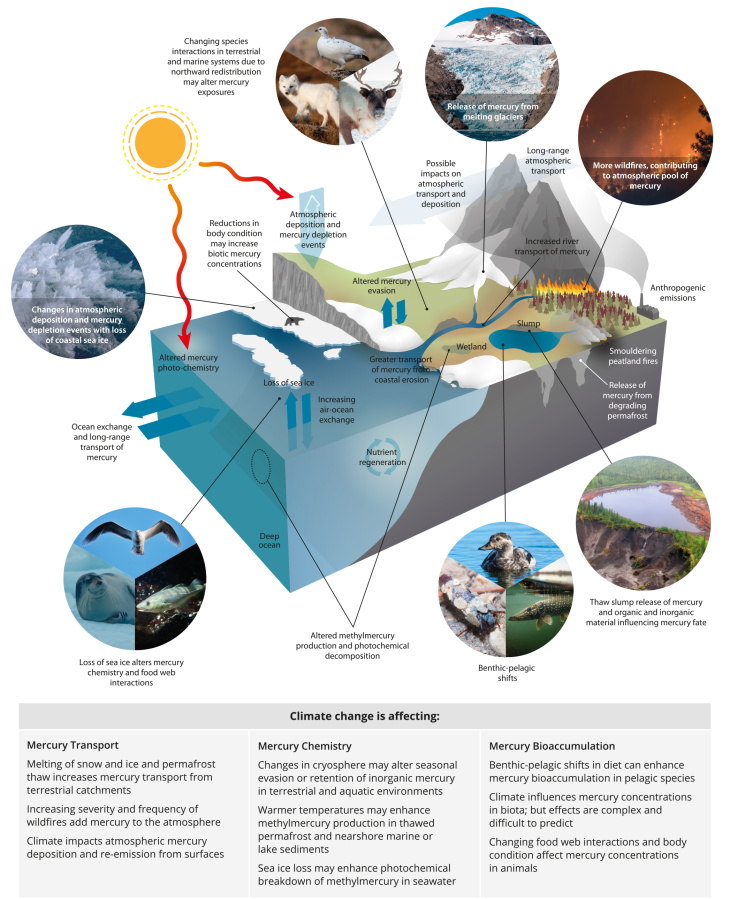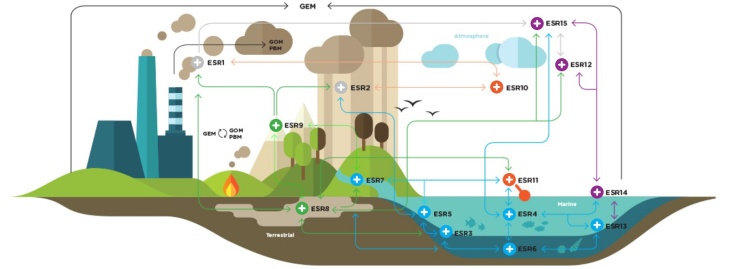Arctic Mercury Cycling - Review
Context

Climate Change affecting mercury cycling (Source: Mercury Assessment. AMAP 2021)
Mercury (Hg) is a quite unique pollutant. First of all it is an element. This means that there is no degradation process and it is stable over millions of years. Even the most stable persistent organic pollutants with lifetimes in the range of decades to centuries seem short-lived in comparison. Moreover, Hg existsts in liquid and gaseous form under natural conditions. This means, that it is readily transported by atmospheric circulation and distributed even in remote regions far away from pollution sources.
Finally, Hg in marine and freshwater environments can react to methylmercury (MeHg). MeHg is a highly bioaccumulative pollutant with a toxicity orders of magnitude higher compared to normal Hg. As currently about 17% of the global human protein consumption is covered by fish and sea food, MeHg has become a pollutant of global concern.
Dastoor, A., Angot, H., Bieser, J. et al. (2022): Arctic mercury cycling. Nature Reviews Earth & Environment (2022), doi: 10.1038/s43017-022-00269-w
Access publication (external link)
Global mercury budget and fluxes

Global mercury budget and fluxes (Source: Mercury Assessment. AMAP 2021) (Source: Mercury Assessment. AMAP 2021)
Over 98% of atmospheric Hg is emitted outside the region and is transported to the Arctic via long-range air and ocean transport. Around two thirds of this Hg is deposited in terrestrial ecosystems, where it predominantly accumulates in soils via vegetation uptake. Rivers and coastal erosion transfer about 80 Mg
per year of terrestrial Hg to the Arctic Ocean, in approximate balance with modelled net terrestrial Hg deposition in the region. The revised Arctic Ocean Hg mass balance suggests net atmospheric Hg deposition to the ocean and that Hg burial in innershelf sediments is underestimated (up to >100%), needing seasonal observations of sediment-ocean Hg exchange.
Terrestrial Hg mobilization pathways from soils and the cryosphere (permafrost, ice, snow and glaciers) remain uncertain. Improved soil, snowpack and glacial Hg inventories, transfer mechanisms of riverine Hg releases under accelerated glacier and soil thaw, coupled atmosphere–terrestrial modelling and monitoring of Hg in sensitive ecosystems, such as fjords, can help to anticipate impacts on downstream Arctic ecosystems.
Access publication (external link)
Key Points from Dastoor, A., Angot, H., Bieser, J. et al., 2022, Nature Reviews Earth & Environment
- Arctic terrestrial mercury emissions from anthropogenic activities Arctic terrestrial mercury (Hg) emissions from anthropogenic activities (14 Mg year−1), wildfires (8.8 ± 6.4 Mg year−1) and soil and vegetation re-volatilization (24 (7–59) Mg year−1) are low compared with deposition (118 ± 20 Mg year−1). Estimates suggest that atmospheric Hg input on land is balanced by riverine and erosional exports.
- Large mercury pools accumulation in permafrost soils Large pools of Hg (~597,000 Mg, 0–3 m depth) have accumulated in permafrost soils. Permafrost thaw is ubiquitous, but impacts Hg mobilization variably across the Arctic, and its future impact is presently uncertain.
- Mercury storage in Arctic glaciers Melt releases ~0.4 Mg year−1 of deposited Hg stored in Arctic glaciers (2,415 Mg), which is dwarfed by ~40 Mg year−1 of geogenic particulate Hg exported by glacial rivers into adjacent seas. Coastal erosion mobilizes an estimated 39 (18–52) Mg year−1 of soil-bound Hg into the Arctic Ocean.
- Pan-Arctic rivers export of mercury to the Arctic Ocean Pan-Arctic rivers export 41 ± 4 Mg year−1 of dissolved and particulate Hg (~50% each) to the Arctic Ocean, predominantly during the spring freshet, likely derived from seasonal snowpacks (≤50%) and active-layer surface soils (≥50%) of the watershed portion north of 60°N.
- Arctic Ocean mercury deposition exceeds evasion Arctic Ocean Hg deposition (65 ± 20 Mg year−1) exceeds evasion (32 (23–45) Mg year−1). The revised Arctic Ocean Hg budget (~1,870 Mg) is lower than previous estimates (2,847–7,920 Mg) and implies higher sensitivity to changes in climate and emissions.
- Importance of Shelf-region particulate mercury settling from surface waters Shelf-region particulate Hg settling (122 ± 55 Mg year−1) from surface waters is the largest Hg removal mechanism in the ocean. The revised Arctic Ocean Hg mass balance suggests that Hg burial in shelf sediments (42 ± 31 Mg year−1) is underestimated by up to 52.2 ± 43.5 Mg year−1.
Climate Change is affecting Arctic Hg cycling
- Mercury Transport Climate impacts atmospheric mercury deposition and re-emission from surfaces such as permafrost soils.
Increasing severity and frequency of wildfires will release large quantities of mercury into the atmosphere.
Melting of snow and ice as well as thawing permafrost will increase mercury transport from terrestrial
catchments into the Arctic ocean. - Mercury Chemistry Changes the in cryosphere may alter seasonal evasion or retention of inorganic mercury in terrestrial and
aquatic environments.
Especially sea ice loss will change Hg fluxes between ocean and atmosphere and may enhance
photochemical breakdown of methylmercury in seawater.
Warmer temperatures and increased light penetraion will impact the marine ecosystem and may enhance
methylmercury production in thawed permafrost and nearshore marine or lake sediments. - Mercury Bioaccumulation Climate influences mercury concentrations in biota but effects are complex and difficult to predict.
Changing food web interactions and body condition affect mercury concentrations in animals and
benthic-pelagic shifts in diet can enhance mercury bioaccumulation in pelagic species.
Regulating Mercury
Minamata Convention on Mercury
The international community has recognized the serious threat Hg posed to human health and on 16th August 2017 the UN Minamata Convention entered into force. The Minamata Convention on Mercury is a multilateral environmental agreement that addresses specific human activities which are contributing to widespread mercury pollution. Implementation of this agreement will help reduce global mercury pollution over the coming decades.
Major highlights of the Minamata Convention include a ban on new mercury mines, the phase-out of existing ones, the phase-out and phase-down of mercury use in a number of products and processes, control measures on emissions to air and on releases to land and water, and the regulation of the informal sector of artisanal and small-scale gold mining. The Convention also addresses interim storage of mercury and its disposal once it becomes waste, sites contaminated by mercury as well as health issues.
The Minamata Convention is named after the Japanese city of Minamata, which experienced a severe, decades-long incidence of mercury poisoning after industrial wastewater from a chemical factory was discharged into Minamata Bay. The wastewater contained methylmercury, which bioaccumulated in fish and shellfish in the bay. Local people who consumed seafood from Minamata Bay became very sick, and many died or were left severely disabled.
Access Minamata Convention information booklet (2019) (external link)
2021 AMAP Mercury Assessment Report
The Arctic Monitoring and Assessment Programme (AMAP) is a group working under the Arctic Council. The Arctic Council Ministers have requested AMAP to:
- produce integrated assessment reports on the status and trends of the conditions of the Arctic ecosystems
- identify possible causes for the changing conditions
- detect emerging problems, their possible causes, and the potential risk to Arctic ecosystems including indigenous peoples and other Arctic residents
- recommend actions required to reduce risks to Arctic ecosystems.
Ten years after the first Arctic Mercruy assessment, AMAP invited researchers around the globe to produce an updated report and to assess the current state and anticipate future changes in arctic Hg cycling.
AMAP (2021): 2021 AMAP Mercury Assessment. Summary for Policy-makers. Arctic Monitoring and Assessment Programme (AMAP), Tromsø, Norway. 16 pp
Access AMAP report (external link)
Marie-Sklodivska Curie International Training Network - GMOS-Train
In 2020 the European Commission funded the integrated training network GMOS-Train. In GMOS-Train 10 Euroepan research institutes jointly train 15 doctoral students with the purpose to better understand the global exchange of Hg between atmosphere, hydrosphere, lithosphere, and biosphere. The project aims to train the next generation of young researchers through a network-based, highly interdisciplinary research training programme including atmospheric chemistry and physics, aquatic chemistry, ecology, analytical chemistry, multimedia modelling, and the use of science results for policy making. An additional feature is the strong inter-sectorial collaboration involving academic and non-academic partners, NGOs and international organisations.

Illustration of the 15 PhD research projects on global Hg cycling and their interaction (Source: GMOS-Train, https://www.gmos-train.eu)


